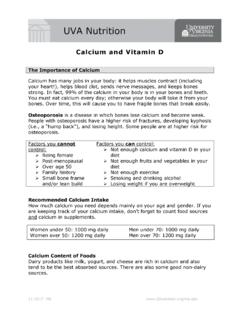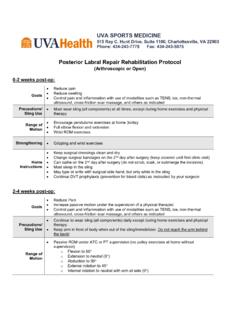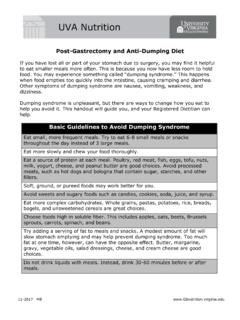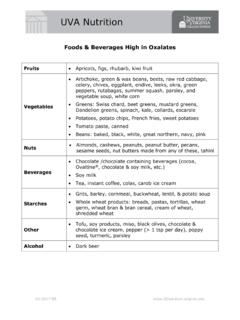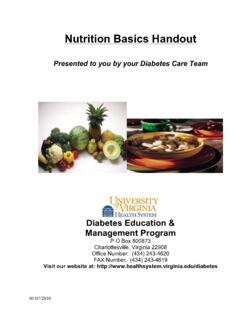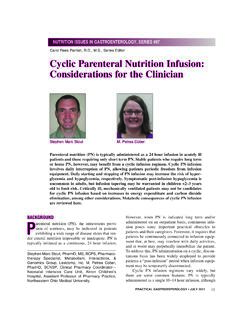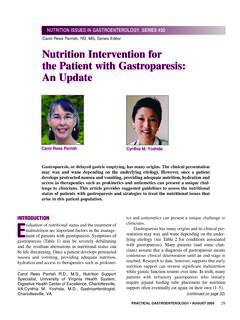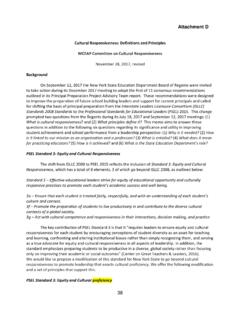Transcription of When Chyle Leaks: Nutrition Management Options
1 PRACTICAL GASTROENTEROLOGY MAY 200460 INTRODUCTIONC hyle is an alkaline, milky, odorless fluid that pro-vides about 200 kcal/liter. It contains greater than30 g/L of protein, 4 40 g/L of lipid (mostly triglyc-eride) and cells consisting primarily of lymphocytes (1). Chyle leaks are a rare complication; they can occur for avariety of reasons after injury to the intra-abdominallymphatics (Table 1). Leakage may manifest as a chy-lothorax or chylous effusion (thoracic cavity); chylousascites (peritoneal cavity); chylopericardium (cardiaccavity) or as an external draining fistula. Approximately60% of Chyle leaks are due to lymphoma; 25% due totrauma (iatrogenic or penetrating); other causes make upthe remaining 15% of cases (2). The incidence of chyleleaks varies depending on the underlying cause. Theincidence after radical neck dissection is 1 (3);after cardiothoracic surgery 1% (2). DIAGNOSISThe diagnosis of a Chyle leak is often subjective, anddiagnostic criteria may vary.
2 To confirm that a fluid ischylous, the lipid content should be greater than that ofplasma and the protein should be more than half of thatof plasma (1). A milky appearance of the drainagefluid is often the initial clue. One simple method sev-eral authors advocate is to restrict enteral fat intake; ifthe drainage becomes clear and/or decreases, it can beassumed that a Chyle leak is present (3,4). Others eval-uate the drainage fluid for characteristics such astriglyceride content, alkaline pH, and presence of fat,When Chyle Leaks: Nutrition Management OptionsNUTRITION ISSUES IN GASTROENTEROLOGY, SERIES #17 Carol Rees Parrish, , MS, Series EditorStacey mccray RD, Nutrition Support Specialist Con-sultant, and Carol Rees Parrish RD, MS, NutritionSupport Specialist, University of Virginia Health System, Digestive Health Center of Excellence, Charlottesville, mccray (continued on page 62)Chylous leakage from the lymphatic system is a complex problem usually resultingfrom injury or abnormality of the thoracic duct.
3 Although rare, when such leaks occur,they are often difficult to manage and correct. Nutrition therapy plays a major role inthe conservative treatment of Chyle leaks. This article will review the process of fatdigestion and absorption, review selected references reporting Nutrition interventions,discuss Nutrition Options for the treatment of a Chyle leak, and provide information toimplement such Rees ParrishPRACTICAL GASTROENTEROLOGY MAY 200462 Nutrition ISSUES IN GASTROENTEROLOGY, SERIES #17 When Chyle Leaksspecific gravity, cholesterol/triglyceride ratio, or lym-phocyte count to confirm the diagnosis (2,5,6). Morecomplete reviews of the etiology and diagnosis ofchyle leaks are available elsewhere (7 9).A BRIEF REVIEW OF FAT DIGESTION AND ABSORPTIONThe majority of dietary fat is in the form of long chain fats(LCF). Digestion and absorption of LCF is a unique andcomplicated process involving multiple gastrointestinalfunctions and the lymphatic system.
4 The process requiresgastric lipase, pancreatic lipase, additional enzymes, asuitable intestinal pH ideally pH 7 (achieved bysecretion of pancreatic bicarbonate) and bile salts. Lymph is derived from interstitial fluid that flowsinto the lymphatics; it is the only means for proteinthat has left the vascular compartment to be returned tothe blood. As a result, the protein content of lymph hasabout the same content as the interstitial fluid. Theamount of protein returned to the blood by the lym-phatics is about one fourth to one half of the circulat-ing plasma protein. Chylomicrons are returned to theblood stream via the thoracic duct, the final commonpathway for all lymphatic flow. Ultimately, it entersthe venous system at the junction of the internal jugu-lar and subclavian veins. Two to four liters of Chyle aretransported through the thoracic duct each day (10).Any factor that increases interstitial fluid pressure willincrease lymph flow such as: Mechanisms that enhance the rate of blood capillaryfiltration such as elevated capillary pressure or per-meability; Decreased plasma colloid osmotic pressure; and Increased interstitial fluid colloid osmotic addition, water taken by mouth can increase theflow of Chyle by 20% (11).
5 After LCF is ingested and delivered into the proxi-mal small bowel, bile salts are released into the lumencreating micelles with the fat particles dissolving thehydrophobic LCF in the aqueous small bowel environ-ment. The formation of micelles increases the surfacearea of LCF allowing easier access to pancreaticenzymes for hydrolysis. Pancreatic lipase is the primaryenzyme involved in the breakdown of LCF. Micellestransport fatty acids and monoglycerides to the intesti-nal villi where they are absorbed across the intestinalmucosa. Absorption of fat takes place primarily in theproximal jejunum. Of note, bile salts are not absorbed atthis point, but continue down the intestine to the ileumwhere they are reabsorbed and returned to the liver viaenterohepatic circulation. This process of recycling bilesalts is required for adequate bile flow to percent of bile salts are recycled in this fashion,making for a very efficient and conservative absorbed across the intestinal mucosa, the fattyacids and monoglycerides are re-esterified into triglyc-erides combining with cholesterol, protein and other sub-stances to form chylomicrons.
6 Chylomicrons enter thelymphatic system as Chyle via lacteals (lymph vessels inthe villous region). Fat-soluble vitamins are also absorbedinto the lymphatic system by this route. The chylomi-crons then travel through the lymph system and aredeposited into the venous blood system over the course ofseveral hours after a meal. Chylomicrons are then clearedfrom the blood stream by the enzyme lipoprotein lipase. Short and medium chain triglycerides (MCT) aremore easily absorbed than LCT. MCT is primarilyabsorbed directly across the intestinal mucosa anddelivered to the portal vein. As the intake of LCTincreases (and hence luminal concentration of LCTincreases) along with MCT intake, a higher percentageof the MCT will also be absorbed via the lymphaticcirculation. Sources, advantages and disadvantages ofMCT will be discussed later in this article. (continued from page 60)(continued on page 64)Table 1 Potential Causes of Chyle Leak Lymphoma Post operative complication Radical Neck Dissection Cardiothoracic surgery Pulmonary resection Penetrating Trauma Lymphangioleiomyomatosis (LAM) Cirrhosis Tuberculosis Congenital Chylothorax (neonates) IdiopathicUsed with permission from the University of Virginia Health SystemNutrition Support Traineeship Syllabus (18)PRACTICAL GASTROENTEROLOGY MAY 200464 Nutrition ISSUES IN GASTROENTEROLOGY, SERIES #17 When Chyle Leaks(continued from page 62)Table 2 Summaries of Selected Chyle Leak ReferencesAuthor(s)/DatesStudy DesignPatient InformationNutrition RegimenAlban CJ, et al; 1990 (19)Case reportsAdults with postoperative Elemental diet followed by low chylous ascites (n = 4; 3M/1F)fat/MCT diet (n = 1)Age: 59 65yrsLow-fat/MCT diet (n = 2)Immediate surgery (n = 1)Al-Khayat M, et al; 1991 (20)Unclear Adults with low volume chylous NPO/TPN (n = 1).
7 The means used to maintain fistulae after neck dissection forNG with water, Calogen (50% postoperative Nutrition was metastatic squamous cell carcinomaarachis oil in water) &/or standard deliberately varied. (n = 3; 3M/0F)tube feeding (TF) (n = 2)Age: 56 60yrsBolger C, et al; 1991 (21)Retrospective chart reviewsPatients with chylothorax after TPNoesophagectomy for carcinoma(n = 11)Age/gender not reportedBrowse NL, et al; 1997 (22)Retrospective, descriptivePatients with spontaneous chylothoraxReported only 1 patient was treated (n = 20; 9M/11F)with a fat free diet and MCT oil Age: 9 mos 78 yrsalone and 1 with repeated pleural aspirations and MCT diet supplementsCelona-Jacobs N, et al; 2000 (23)Case reportAdult with congenital lympangiectasiaDiet restricted initially to 15% animal (n = 1; 0M/1F)fat w/ 6 tbsp MCT oil, then animal fat Age: 28yrswas further restricted to 5% animal fat with 8 tbsp MCT oil. 2 3% EFA in the form of corn oil Gier HHW, et al; 1996 (3)Chart reviewsChylous fistulas in adults with MCT oral diet, then Peptison via head/neck cancersnasogastric tube, then TPN when (n = 11; 8M/3F)first two methods failed.
8 Age: 32 76 yrsDougenis D, et al; 1992 (24)Chart reviewsAdults with postoperative chylothorax Clear liquids / TPNafter esophagogastrectomies (n = 10;7M/3F)Age: 37 81 yrsDugue L, et al; 1998 (25)Retrospective, descriptiveAll pts w/ esophageal CA undergoing TPN x 12 daysLewis procedure w/ chylothorax(n = 23; 19M/4F)Age: 34 73yrsGolden P, et al; 1999 (14)Case reportAdult with blunt trauma after MVA~Day 6 or 7 chylothorax diagnosed, (n = 1; 0M/1F)20 g MCT diet started, followed by Age: 53yrsTPN for 4 days without resolution. Day 12, 200 mL olive oil was given via NGT prior to surgery for RT, et al; 2000 (4)Retrospective, Adults with Head/Neck cancersVital HN, then TPN (n= 3)Descriptive, Case series(n = 5; 5M/0F)Peptison (n = 2)Age: 42 69yrsHashim SA, et al; 1964 (26)Case ReportsAdults with chyluria, chylothoraxDiets were isocaloric, homogenized (n = 2; 2M/0F)liquid formula of 40% fat (variousAge: 63, 51 yrstypes used), 45% CHO and 15% protein providing 35 kcal/kg and vitamins/minerals followed for 26 weeks and 10 weeks respectively after which a fat free diet was GASTROENTEROLOGY MAY 200465 Nutrition ISSUES IN GASTROENTEROLOGY, SERIES #17 When Chyle LeaksStudy EndpointsResultsAuthors Conclusionsn/aAscites resolved in 3/4 patients (2 responded to Treatment of chylous ascites varies low-fat/MCT diet and 1 to surgery) depending on individual patient One patient on the low-fat/MCT diet died from presentation.
9 Options for Nutrition complications of his conditionmanagement include: elemental diet, low fat/MCT diet, or TPNF istula drainageAdministration of standard TF resulted in a transient In the Management of fistulae producing increase in drainage in one patient, however, overall small amounts of Chyle , ..the use of the administration of clear liquids, Calogen &/or TF parenteral Nutrition with its potential did not result in a significant increase in wound or drawbacks and attendant costs is unjustified fistula drainagein these cases. Successful conservative 8 pts were managed conservatively; 3 required Mortality rate is high in patients who managementthoracotomy develop chylothorax after oesophagectomy 5 pts died of there is no significant difference between the conservative or surgical approachInterventions undertaken Child treated with MCT oil and diet alive at 10 yearsDrainage of effusion, a low fat diet w/ MCT SurvivalPatient needing repeated pleural aspirations expired Doil is helpful in some patients; if fluid loss after 3 years exceeds L/day (adults) or 100mL/day in child for >5 7 days, drainage should be stopped.
10 Replace all fluid, protein and electrolytes via in right pleural effusionSignificant decrease in size of right pleural effusion A fat restricted diet using MCT successfully Nutritional further thoracentesis for >24 monthsdecreased chylous effusion over a 24-month Nutritional status remained avoiding the use of tube drainage <25 mL/24 5 closed with MCT diet alone; 6 with TPN MCT diet should be tried first; if drain hours before drains pts ultimately required surgical does not decrease, Peptison TF should be tried; TPN as last resort for ~30 days before surgical factorsOne patient was successfully treated with a closed Early reintervention by a repeat thoracotomy Successful fistula managementtube thoracostomy and TPN aloneis recommended for patients who Eight patients underwent ligation of the major thoracic experience chylothorax after esophageal duct; the procedure was successful in 7/8 patientssurgery for carcinomaChylous output <500 mL or14 pts recovered without reexploration Medical Management was successful in reexpansion of lung1 pt had septic complication from TPN 61% of patients; a daily chylous output of Ratio of chylous flow to body-weight Patients with mean Chyle outflow <10 mL/kg did <10 mL/kg is reliable for predicting day 1 & 5 following onset of not require reoperationsuccessful medical Management within 12 chylothoraxdays of in Chyle change in Chyle drainage noted even on TPN, No standard treatment of chylothorax is therefore pt closure or reoperate3 with spontaneous closureTry MCT nasogastric diet, then TPN if leak does not stop.

